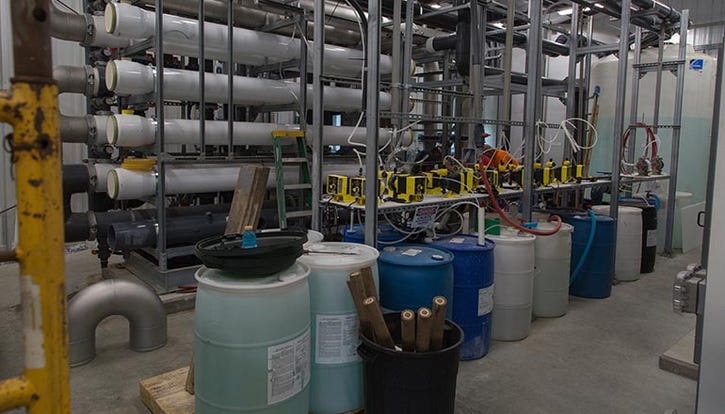What Emerging Contaminants are on Whose Radar?
The term “emerging contaminants” is somewhat of a misnomer in that some of these constituents have been well recognized for decades.

“Emerging contaminants of concern” is now a buzz term in the solid waste management arena. Generally, the term refers to chemicals that can be found in leachate that are on some researchers’ and regulators’ radar due to possible health and environmental risks. The leachate typically moves on to wastewater treatment plants, and these contaminants end up in surface water.
The term “emerging contaminants” is somewhat of a misnomer in that some of these constituents have been well recognized for decades, though are lately seen in increasing concentrations in water, whether because of better detection methods or other reasons. But a few have been only recently identified.
“Among [emerging contaminants] we think will become major issues over the next five years or sooner is 1,4-dioxane [in paint strippers, dyes, antifreeze and other industrial products]. Others coming up are compounds in pharmaceuticals, personal care products and microplastics,” says Patrick Stanford, general manager for Rochem Americas, a water treatment equipment manufacturer based in Hermosa Beach, Calif.
Meanwhile, there are few regulations to address most of the contaminants that have come into question. However, the U.S. Environmental Protection Agency (EPA) and some states are starting to look closely at some of them, with Michigan in the forefront. Manufacturers are on the wing with their broad-application leachate treatment systems that they expect may play a growing role in addressing emerging contaminants.
Per- and polyfluoroalkyl substances (PFAS), especially, are on the edge now. Thousands of chemicals fall under this category and are used in products from nonstick cookware to waterproof fabrics. Research links some PFAS to cancer, kidney problems and other health issues. EPA just awarded $6M to research impacts of PFAS in waste streams and released its PFAS Action Plan.
These PFAS, as well as materials that interfere with ultraviolet light (UV) transmittance, appear to be closest to regulatory implementation, observes Ryan Schipper, senior project engineer at Golder Associates.
Materials in leachate, disruptive to UV transmittance, are driving wastewater treatment plants to action. They are mainly organics and organic acids like humic acids and fulvic acids that degrade in landfill.
The issue is that they interfere with a process that many wastewater treatment plants are adopting called UV disinfection, which uses light to kill pathogens.
“Changing to UV disinfection helps to minimize carcinogenic byproducts generated from the disinfection process. But materials in leachate that interfere with UV transmittance compromise the UV systems’ capabilities,” says Schipper.
Consequently, wastewater treatment plants may not meet requirements for disinfection. If operators identify landfill leachate as the issue, leachate will likely have to be pretreated, or be rejected.
Many constituents in personal care products and in pharmaceuticals are issues, too.
“Some of them may be in leachate and, when discharged to wastewater treatment plants, not all are degraded. Ultimately, they are discharged with the wastewater effluent into water bodies,” says Ivan Cooper, Civil & Environmental Consultants (CEC) principal and national water/wastewater practice leader.
Microplastics (particles under 15 microns) are garnering scrutiny.
“Microplastics can form a media that other bacteria can grow on, and we haven’t confirmed their health effects, nor are there standard methods for testing for the presence of microplastics,” says Cooper.

Three main leachate treatment technologies address the problems around emerging contaminants to a degree: reverse osmosis, activated carbon and ion exchange.
Reverse osmosis is generally considered the most effective broad-spectrum treatment system. Through this process, most material passes through a membrane as treated water and the remaining contaminants are retained by the membranes.
Stanford says Rochem’s reverse osmosis technology can normally reduce the volume of contaminated water to 5 to 10 percent of the original leachate volume.
Cooper says while firms like CEC look at reverse osmosis, the technology is limited, as residuals left after separation contain high concentrations of contaminants that have to be managed.
But another technology, phytoremediation, addresses the residue issue and has other benefits. Phytoremediation involves installing a drip irrigation system down rows of trees, which distributes leachate. The trees take up the constituents.
If well designed and maintained, phytoremediation can be inexpensive and effective, says Cooper.
Meanwhile, relatively few landfill operators are gearing up to address contaminants that are so far unregulated.
Stanford says Rochem’s customers invest in its equipment primarily to cost effectively manage leachate in general as required, or for disposal options.
But Cooper says, “While we are focused around what is currently regulated, we are also starting to be aware of what might bite us later.”
Even as research discloses more, the need for more studies will be ongoing, as chemicals are manufactured faster than they are tested, says Mort Barlaz, head of the department of Civil, Construction, & Environmental Engineering at North Carolina State University, Raleigh.
“We need to adapt management strategies which recognize that there will always be unknowns,” he says. “It means we will need to take steps to remove contaminants before they release to the environment … And I think landfill owners need to look at whether leachate is a significant contributor to emerging contaminants entering wastewater treatment plants. If it is, industry needs to work with those treatment plants on strategies to manage the contaminants.”
About the Author
You May Also Like




